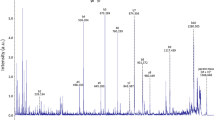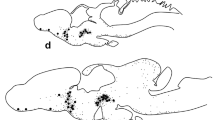Abstract
The discovery of gonadotropin-inhibitory hormone (GnIH) in Japanese Quail Coturnix japonica has given us a new perspective on the neuroendocrine control of reproductive physiology and behavior. Using highly photoperiodic passerine songbirds as our model system, we have been able to investigate GnIH neuroanatomy and functional biology. The distribution of GnIH peptide is similar among the galliform and passerine species studied so far. We have identified GnIH cDNA and localized its transcript in Gambel’s White-crowned Sparrow Zonotrichia leucophrys gambelii. There is a high degree of homology between the galliform and passerine GnIH cDNA sequences and peptides. Based on transcript localization, GnIH precursor polypeptide is only produced in the paraventricular nucleus, yet GnIH-immunoreactive fibers project to multiple brain areas, suggesting multiple physiological and behavioral functions. GnIH immunoreactive neurons appear to contact gonadotropin-releasing hormone (GnRH)-I and -II neurons, raising the possibility of direct regulation of GnRH by GnIH. In a photoperiod experiment, GnIH neurons increased in area during the termination of reproduction in Song Sparrows, Melospiza melodia, implying temporal photoperiodic regulation of this neuropeptide. Using peripheral administration of GnIH in vivo, we demonstrated rapid inhibition of LH release in laboratory and field experiments. Furthermore, we sought to determine the effects of central infusions of GnIH. Centrally-administered GnIH rapidly reduced circulating LH and significantly reduced the number of copulation solicitations performed in response to song playback, with no reduction of locomotor activity. Central infusion of rhodaminated GnIH elucidated putative GnIH binding sites in the median eminence close to GnRH-I fiber terminals, and in the midbrain on or close to GnRH-II neurons. These data demonstrate direct effects of GnIH upon reproductive physiology and behavior, possibly at multiple physiological levels and over different time-frames. Thus, the discovery of GnIH has unearthed a complex and interesting system for the regulation of avian reproductive biology.


Similar content being viewed by others
References
Anderson GM, Steyn FJ, Tsutsui K, Ukena K, Bentley GE, Herbison AE (2005) Is there a gonadotrophin-inhibitory hormone system in mammals? 35th Annual Meeting for the Society for Neuroscience (Abstract), Washington, DC
Beach FA, Stern B, Charmichael M, Ranson E (1976) Comparisons of sexual receptivity and proceptivity in female hamsters. Behav Biol 18:473–487
Bentley GE, Perfito N, Ukena K, Tsutsui K, Wingfield JC (2003) Gonadotropin-inhibitory peptide in song sparrows (Melospiza melodia) in different reproductive conditions, and in house sparrows (Passer domesticus) relative to chicken-gonadotropin-releasing hormone. J Neuroendocrinol 15:794–802
Bentley GE, Jensen JP, Kaur GJ, Wacker DW, Tsutsui K, Wingfield JC (2006a) Rapid inhibition of female sexual behavior by gonadotropin-inhibitory hormone (GnIH). Horm Behav 49:550–555
Bentley GE, Perfito N, Moore IT, Ukena K, Tsutsui K, Wingfield JC (2006b) Gonadotropin-Inhibitory hormone in birds: possible modes of action. Acta Zool Sinica 52:178–182
Brenowitz EA (1991) Altered perception of species-specific song by female birds after lesions of a forebrain nucleus. Science 251:303–305
Chartrel N, Dujardin C, Anouar Y, Leprince J, Decker A, Clerens S, Do-Rego JC, Vandesande F, Llorens-Cortes C, Costentin J, Beauvillain JC, Vaudry H (2003) Identification of 26RFa, a hypothalamic neuropeptide of the RFamide peptide family with orexigenic activity. Proc Natl Acad Sci USA 100:15247–15252
Ciccone NA, Dunn IC, Boswell T, Tsutsui K, Ubuka T, Ukena K, Sharp PJ (2004) Gonadotrophin inhibitory hormone depresses gonadotrophin α- and follicle-stimulating hormoneβ-subunit expression in the pituitary of the domestic chicken. J Neuroendocrinol 16:999–1006
Dawson A, Sharp PJ (2007) Photorefractoriness in birds-photoperiodic and non-photoperiodic control. Gen Comp Endocrinol (in press)
Dawson A, Talbot RT, Dunn IC, Sharp PJ (2002) Changes in basal hypothalamic chicken gonadotropin-releasing hormone-I and vasoactive intestinal polypeptide associated with a photo-induced cycle in gonadal maturation and prolactin secretion in intact and thyroidectomized starlings (Sturnus vulgaris). J Neuroendocrinol 14:533–539
Dawson A, King VM, Bentley GE, Ball GF (2001) Photoperiodic control of seasonality in birds. J Biol Rhythms 16:365–380
Deviche P, Small T, Sharp P, Tsutsui K (2006) Control of luteinizing hormone and testosterone secretion in a flexibly breeding male passerine, the Rufous-winged Sparrow, Aimophila carpalis. Gen Comp Endocrinol 149:226–235
Dudley CA, Vale W, Rivier J, Moss RL (1983) Facilitation of sexual receptivity in the female rat by a fragment of the LHRH decapeptide, Ac-LHRH5–10. Neuroendocrinology 36:486–488
Johnson MA, Tsutsui K, Fraley GS (2007) Rat RFamide-related peptide-3 stimulates GH secretion, inhibits LH secretion, and has variable effects on sex behavior in the adult male rat. Horm Behav 51:171–180
King AP, West MJ (1977) Species identification in the North American cowbird: appropriate response to abnormal song. Science 195:1002–1004
Kriegsfeld LJ, Feng-Mei D, Bentley GE, Ukena K, Tsutsui K, Silver R (2006) Identification and characterization of a Gonadotropin-inhibitory system in the brains of mammals. Proc Natl Acad Sci USA 103:2410–2415
Maney DL, Richardson RD, Wingfield JC (1997) Central administration of chicken gonadotropin-releasing hormone-II enhances courtship behavior in a female sparrow. Horm Behav 32:11–18
Moss RL, McCann SM (1973) Induction of mating behavior in rats by luteinizing hormone-releasing factor. Science 181:177–179
Moss RL, McCann SM (1975) Action of luteinizing hormone-releasing factor (LRF) in the inititation of lordosis behavior in the estrone-primed ovariectomized female rat. Neuroendocrinology 17:309–318
Nicholls TJ, Goldsmith AR, Dawson A (1988) Photorefractoriness in birds and comparison with mammals. Physiol Rev 68:133–176
Osugi T, Ukena K, Bentley GE, O’Brien S, Moore IT, Wingfield JC, Tsutsui K (2004) Gonadotropin-inhibitory hormone in Gambel’s white-crowned sparrows: cDNA identification, transcript localization and functional effects in laboratory and field experiments. J Endocrinol 182:33–42
Osugi T, Ukena K, Sower SA, Kawauchi H, Tsutsui K (2006) Evolutionary origin and divergence of PQRFamide peptides and LPXRFamide peptides in the RFamide peptide family. Insights from novel lamprey RFamide peptides. FEBS J 273:1731–1743
Parry DM, Goldsmith AR, Millar RP, Glennie LM (1997) Immunocytochemical localization of GnRH precursor in the hypothalamus of European starlings during sexual maturation and photorefractoriness. J Neuroendocrinol 9:235–243
Pfaff DW (1973) Luteinizing hormone-releasing factor (LRF) potentiates lordosis behavior in hypophysectomized ovariectomized female rats. Science 182:1148–1149
Price DA, Greenberg MJ (1977) Structure of a molluscan cardioexcitatory neuropeptide. Science 197:670–671
Rowan W (1925) Relation of light to bird migration and developmental changes. Nature 115:494–495
Sakuma Y, Pfaff DW (1983) Modulation of the lordosis reflex in female rats by LHRH, its antiserum and analogs in the mesencephalic central gray. Neuroendocrinol 36:218–224
Searcy WA (1992) Measuring responses of female birds to male song. In: McGregor PK (ed) Playback and studies of animal communication. Plenum, New York, pp 175–189
Tsutsui K, Saigoh E, Ukena K, Teranishi H, Fujisawa Y, Kikuchi M, Ishii S, Sharp PJ (2000) A novel avian hypothalamic peptide inhibiting gonadotropin release. Biochem Biophys Res Commun 275:661–667
Ubuka T, Binns M, Cadigan PA, Osugi T, Chowdhury VS, Tsutsui K, Bentley GE (2006a) Identification of Gonadotropin-inhibitory Hormone in Human Brain. Soc Neurosci Abstr
Ubuka T, Ukena K, Sharp PJ, Bentley GE, Tsutsui K (2006b) Gonadotropin-inhibitory hormone inhibits gonadal development and maintenance by decreasing gonadotropin synthesis and release in male quail. Endocrinology 147:1187–1194
Wingfield JC, Crim JW, Mattocks PW Jr., Farner DS (1979) Responses of photosensitive and photorefractory male white-crowned sparrows (Zonotrichia leucophrys gambelii) to synthetic mammalian luteinizing hormone releasing hormone (syn-LHRH). Biol Reprod 21:801–806
Wingfield JC, Farner DS (1993) The endocrinology of wild species. In: Farner DS, King JR, Parkes KC (eds) Avian biology, vol 9. Academic, New York pp 163–327
Yin H, Ukena K, Ubuka T, Tsutsui K (2005) A novel G protein-coupled receptor for gonadotropin-inhibitory hormone in the Japanese quail (Coturnix japonica):Identification, expression and binding activity. J Endocrinol 184:257–266
Acknowledgements
This work was supported by Grants-in-Aid for Scientific Research from the Ministry of Education, Science and Culture, Japan (15207007, 16086206 and 18107002); NIH, USA (RO1 MH065974); NSF, USA (IOB-0641188) and a UC Berkeley Committee on Research Junior Faculty Research Grant.
Author information
Authors and Affiliations
Corresponding author
Additional information
Communicated by F. Bairlein.
Rights and permissions
About this article
Cite this article
Bentley, G.E., Perfito, N., Ubuka, T. et al. Gonadotropin-inhibitory hormone in seasonally-breeding songbirds: neuroanatomy and functional biology. J Ornithol 148 (Suppl 2), 521–526 (2007). https://doi.org/10.1007/s10336-007-0217-2
Received:
Revised:
Accepted:
Published:
Issue Date:
DOI: https://doi.org/10.1007/s10336-007-0217-2




